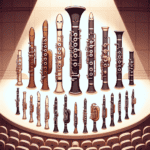Introduction to Clarinet Case Designs
Clarinet enthusiasts often focus on the instrument itself, but clarinet case designs hold a history just as remarkable as the clarinet. If you've ever wondered how historical clarinet case designs have evolved over time, you're not alone. Let's explore the fascinating evolution of these protective and often stylish tools that keep our beloved instruments safe.
Early Designs: 18th and 19th Centuries
Back in the day—think 18th and 19th centuries—clarinet cases were significantly different from what we see now. Early wooden clarinets were often housed in handcrafted wooden cases. These cases were carefully carved from durable timbers and lined with plush fabrics like velvet. They weren't just for protection; many cases were works of art, often adorned with intricate brass fittings and detailed carvings. Can you imagine carrying one of those to your next gig?
Craftsmanship was paramount in the early days, but utility wasn't overlooked. Some cases even had compartments for reeds, cleaning rods, and sheet music—although you'd need a keen eye to spot them in the heavily ornate interiors. It's safe to say they served as both musical storage and conversation pieces. However, these cases weren't exactly lightweight. Their solid construction made them cumbersome to carry, especially when compared to modern options.
| Era | Materials | Features |
|---|---|---|
| 18th-19th Century | Wood, Velvet | Ornate, Heavy, Artistic |
| Mid-20th Century | Aluminum, Hard Plastics | Durable, Portable, Affordable |
| Modern Era | Carbon Fiber, Memory Foam | Lightweight, Shock-absorbent, Versatile |
Mid-20th Century: A Practical Shift
Fast-forward to the mid-20th century, and things started taking a practical shift. Materials like aluminum and hard plastics gained popularity. These modern cases weren't nearly as luxurious as their predecessors, but they offered improved durability and portability, a feature traveling musicians deeply appreciated. Around this time, brands like Martin Freres Clarinets took note, ensuring their clarinets paired well with cases that balanced style, functionality, and affordability.
Contemporary Designs: Innovation Meets Aesthetics
Contemporary cases have embraced innovation without losing sight of aesthetics. Most modern designs include lightweight materials like carbon fiber that keep cases feather-light but robust enough to handle the rigors of travel. The interiors have also seen upgrades. Memory foam and shock-absorbent padding ensure the clarinet is cradled carefully with hardly a scratch in sight.
Modern Styles: From Minimalist to Luxurious
Of course, we can't forget about the range of styles available today. Some cases are minimalist in design, focusing strictly on protection, while others resemble high-end bags, complete with exotic leather finishes and intricate stitching. These luxurious options look like something you'd see at a high-fashion show rather than a music store. Though pricier, they showcase how far clarinet case designs have come.
The Enduring Appeal of Vintage Cases
Despite all the modern advances, some musicians still seek out vintage cases. These collectors appreciate the charm and craftsmanship of antiques and often feel they carry a piece of history along with their instrument. Think of it like owning a well-preserved family heirloom—it's not just an accessory but a window to a bygone era.
Choosing the Right Case for You
When picking the ideal case for your clarinet, it helps to look back at these historical clarinet case designs. There's something truly special about knowing the roots of such a functional yet artistic component of your musical journey.
Whether you value aesthetics, durability, or a mix of both, understanding the evolution of clarinet case designs makes you better equipped to select a case that complements your needs and taste. After all, every clarinet—and its case—tells a story. Make sure yours is one you're proud to carry.







